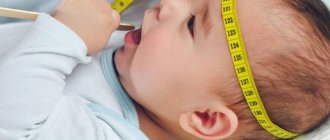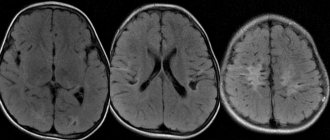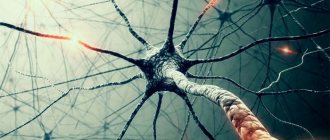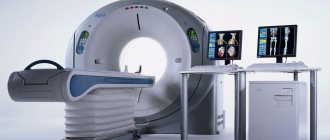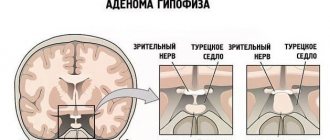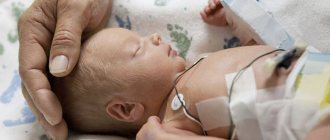Diencephalic structures in the risk area
Dysfunction of midline structures (DSD) in children affects the child’s central nervous system during intrauterine development and can be a consequence of trauma at birth, ischemia and a number of other factors.
One of the reasons is encephalopathy, characterized by changes in the cerebral cortex. Sometimes formational cells connected to the cortex by reciprocal and ascending pathways are also affected. Dysfunction is manifested by a number of pathological signs, from movement disorders to disturbances in concentration, learning, etc.
DSS in adults can be:
- primary (occurs in diseases that directly damage the brain, such as head injury);
- secondary (impaired brain functioning is one of the symptoms of complete organic damage to other body systems).
Most often, dysfunction of the median structures occurs in adults with insufficient blood circulation, therefore, a deficiency of vascular supply to the brain (for example, after a stroke). The following factors are the presence of degenerative, ischemic, autoimmune, toxic and other disorders, impaired venous blood flow. Sometimes the cause is cardiovascular disease (in particular, heart attack).
The main risk factor is a hereditary predisposition that a child can inherit from parents or close relatives. Inheritance is responsible for the development of DSS in 50-70%. In 1998, a gene causing dyslexia was discovered. It is located on the chromosome responsible for controlling the immune system. This explains the fact that patients with DSS are much more prone to allergies and various infections.
Additional risks come from factors affecting the expectant mother during pregnancy. These include:
- viral infections;
- injuries;
- mental stress;
- shock;
- risky pregnancy;
- alcohol consumption;
- smoking.
Complications during childbirth can also cause the development of DSS, such as:
- hypoxia (insufficient blood supply to the newborn’s brain), which damages subcortical structures;
- use of forceps during childbirth;
- bilirubinemia (postpartum jaundice).
These complications represent a 20-30% risk of developing dysfunction.
Factors affecting the baby after birth include:
- high temperature in the first years of life;
- encephalitis;
- meningitis;
- head injuries.
Disorders can spread to different parts of the brain, which is reflected in symptoms; for example, when the intermediate part in the area of diencephalic structures is affected, the dysfunction is characterized by problems with metabolic processes, sleep disorders and a clinical picture characteristic of other areas.
Irritation manifests itself as irritation of the brain. Symptoms will vary depending on the area affected. Usually, irritation is not a separate disease, but a consequence of the course of another disease (tumor, neuroinfection, etc.).
Epilepsy attacks are the result of dysfunction of the midline and stem structures of the brain. Speech and autonomic system disorders are also detected. If the lower parts are damaged, problems with consciousness (confusion with time), attention, and memory may occur.
Minimal dysfunction
In percentage terms, this type of disease affects 1/5 of the patients. Most often, deviation occurs due to oxygen deficiency, injuries received during pregnancy or during childbirth. Experts define this form of pathology as a mild degree of damage to structures, causing a minimal number of consequences, among which the most common are memory impairment, decreased or increased activity of the child, decreased ability to concentrate, fatigue, and developmental inhibition.
Note! Hyperactive children with damage to the brainstem are characterized by excessive impulsiveness, have difficulties with learning, concentrating and remembering the material covered, often cannot write correctly, and are characterized by impaired orientation in space.
Children with reduced activity seem lethargic and apathetic; they may have problems with the functioning of the speech apparatus and pathologies in the functioning of the nervous autonomic system. Such teenagers have a high risk of becoming antisocial citizens, they develop early cravings for alcohol and drugs, and they begin to be sexually active earlier than their peers.
PREVENTION
Prevention of diencephalic syndrome mainly includes protection from infectious diseases that can cause such a syndrome. Take care of your health, do not risk your life so as not to get the same traumatic brain injury, listen to the recommendations of doctors when fighting certain diseases - these are the main tips that will help you avoid diencephalic syndrome.
Studies have shown that specific stimulation during pregnancy can prevent underdevelopment of brain activity. This is prenatal training, in which the nerve cells (neurons) of the fetus are activated by precise sound stimulation. This stimulation provides increased brain function. Children stimulated in this way are born at higher birth weights and begin to talk and walk earlier than their peers.
Your IP address is blocked.
The results of clustering the data of the neuropsychological study and comparing them with the data of electroencephalography in children and adolescents with mental disorders Scientific Center for Mental Health, Moscow, Russia Moscow State Psychological and Pedagogical University, Moscow, Russia. Information about the authors Literature Citation link. The results of clustering data from a neuropsychological analysis of neurocognitive deficits in a group of mentally ill children and adolescents are presented. The profiles of neurocognitive deficits were compared with electroencephalography data in the resulting clusters.
SYMPTOMS
Due to the fact that the functionality of the hypothalamus is quite wide, the symptoms of this syndrome can be different. With this disease, you may experience:
- Disturbances in the functioning of the autonomic-vascular system, which are accompanied by suffocation, drowsiness and other unpleasant moments;
- Thermoregulation disorders: sudden increase in temperature, increased sweating;
- Neuromuscular disorders, expressed in the fact that the patient suffers from weakness, a constant desire to sleep, etc.;
- Neurotrophic disorders: itching, dryness, etc.
- Disturbances in the functioning of the nervous system, which manifest themselves as disturbances in sleep rhythm, mental inactivity;
- Hypothalamic epilepsy, which causes attacks of the well-known epilepsy, only the cause of such a disease is a disturbance in the functioning of the hypothalamus;
- Disorders of the body's endocrine function.
The latter category includes Cushing's disease, which causes excess synthesis of adrenocorticotropic hormone, which negatively affects the production of glucocorticoids by the adrenal glands. The main symptoms of this disease:
- High blood pressure;
- Increased blood sugar;
- Changes in the shape of the face, it becomes moon-shaped;
- Redness of the cheeks;
- The presence of purple stripes, rashes, boils.
Patients suffering from this disease experience disruption of the menstrual cycle, inability to conceive a child, and decreased libido.
Often, diencephalic syndrome manifests itself after childbirth, when the resulting bleeding leads to vasospasm, which occurs even in the brain. This leads to the development of ischemia, and then to negative changes affecting the pituitary gland and the hypothalamic nuclei. This condition is called Simmonds-Sheehan syndrome, the symptoms of which are expressed in the absence of milk production in women in labor. The following is observed: weight decreases sharply, headaches often occur, blood pressure drops, etc.
Diencephalic syndrome: causes, signs and manifestations, diagnosis, how to treat
Diencephalic syndrome is a complex symptom complex that indicates the development of serious disorders in the body and is manifested by signs of vegetative disorders, trophism and endocrinopathies.
The disease develops as a result of damage to the structures of the hypothalamic-pituitary zone: thalamus, hypothalamus, epithalamus, pituitary gland. These organs actively interact with each other, are in close neurohumoral connection and regulate the functioning of the entire organism.
When diencephalic structures are damaged, a syndrome develops, manifested by signs of endocrine and nervous dysfunction.
The hypothalamus plays a huge role in the functioning of the entire body. It secretes statins and liberins, which stimulate or inhibit the activity of hormone-producing cells of the pituitary gland.
At the same time, the secretion of tropins, which realize their physiological effect by influencing the synthesis of hormones of the peripheral endocrine glands, decreases or increases. By influencing the thyroid gland, ovaries and testes, and adrenal glands, the pituitary gland regulates the functioning of internal organs.
Elements of the hypothalamic-pituitary system exist in close interaction. Any malfunctions in the functioning of this system immediately affect the functioning of almost all organs.
Hypothalamic syndrome develops when there is dysfunction of the hypothalamus. Patients experience changes in body weight, headaches, mood changes often, hypertension develops, the menstrual cycle is disrupted, thirst occurs, and libido changes.
The syndrome first appears in adolescents aged 13-15 years. Clinical signs become most pronounced at 30-40 years of age. The syndrome develops more often in women and affects their reproductive health.
Patients are diagnosed with endocrine infertility, polycystic ovary syndrome, and perinatal pathologies.
Diencephalic syndrome has an ICD-10 code E23.3 and refers to “Dysfunctions of the hypothalamus, not classified elsewhere.” Pathology disrupts the process of normal development in children. In them, dysfunction of the hypothalamus also manifests itself as signs of damage to the endocrine glands and nervous system.
Signs of dysfunction arising in the midline structures
Signs of dysfunction that has arisen in the diencephalic-stem structures of the brain are polymorphic, nonspecific, and manifest themselves in many forms and variations. Frequently encountered:
- Pupil dilation.
- Blurred consciousness.
- Cerebral hypertension.
- Arrhythmia (tachycardia, bradycardia).
- Abnormal heart rhythm.
- Increased muscle tone.
- Increased sweating.
Symptoms may be supplemented by loss of skin sensitivity, increased susceptibility to pain, and tremors of the limbs, which are clearly visible even at rest.
During childhood development, it is difficult to identify DSS. Sometimes children are more restless than others and suffer from jet lag (sleep and wakefulness). Infants may have problems with breastfeeding and causeless crying.
During the developmental period, these children, as a rule, become more mobile and more often suffer from injuries. They may experience a “displacement” of development or skip one of the stages of verticalization (most often crawling), and an inability to concentrate on the game. Increased agitation and clumsiness may appear.
Also worth paying attention to are the first emotional outbursts of the nature of anger and aggression. Although these manifestations are nonspecific, often observed in other children at a certain period of development, with brain dysfunction they seem unusually expressive.
A common manifestation is delayed speech development, general slow or uneven development. Sometimes children are superior to their classmates in some school subjects (for example, in mathematics), while in others they show below average success (for example, their native language).
General impairment of cognitive functions is observed with damage to the basal cholinergic system.
Dysfunction of the midline structures of the brain is characterized by a wide range of symptoms. In particular, children of preschool and school age exhibit:
- movement disorders;
- emotional and behavioral disorders;
- impaired concentration and memory;
- disorders of speech, perception and thinking.
Disorders in the motor area consist of a failure in the process of arousal and calm (hyperactivity, hypoactivity). It is also manifested by increased fatigue, but an inadequate reaction (a restless child becomes even more hyperactive, a calm child is more prone to hypoactivity). But both forms are accompanied by increased irritability.
One of the signs of dysfunction of the midbrain system is a violation of gross and fine motor skills, manifested in general motor or graphomotor inefficiency.
Manifestations of improper functioning of the upper-stem and lower-stem systems include emotional disorders. Emotional lability is manifested by changes in mood, tendency to affectivity and aggressiveness.
Children with brain dysfunction often act impulsively - they immediately do what they want at the moment, without thinking about the consequences of their actions. They also have a low tolerance for frustration - some stimuli can lead to an affective explosion. Although these children are very sensitive and sometimes hypersensitive, they have difficulty empathizing with other people's feelings. They often hurt others without realizing it.
Since such children are often ignored by others due to inappropriate behavior, they try to attract attention to themselves. But they do it in an inadequate way - they scream, “explode”, thus closing a circle around themselves.
Children with attention deficits are often distracted and cannot focus. Their activity is easily interrupted by any stimulus. They often forget not only instructions, but also their things and lose them. Often they do not remember where and why they went, what they wanted to do.
Speech, perception and thinking disorders manifest themselves in slow speech development with defects in pronunciation (dyslalia). Speech motor disorder is associated with difficulty pronouncing longer, more complex words. Poor vocabulary is reflected by thinking disorders, because thinking is closely related to speech.
The above symptoms do not appear in every child with impaired brain function. The degree of their severity also varies. Many signs weaken with maturation of the central nervous system.
Symptoms, as in childhood, are varied. These include:
- inattention;
- anxiety;
- ease of distraction;
- impulsiveness;
- moodiness;
- explosive character;
- inability to express an opinion;
- disobedience;
- aggression;
- learning difficulties.
Damage to the mediobasal structures is manifested by impaired speech, analytical abilities, and concentration.
When mesencephalic structures are affected, parkinsonism, cerebellar disorders, and hyperkinesis occur. Dysfunction of the midbrain structures can cause epileptic seizures along with impaired speech development.
Some (more severe) brain dysfunctions are a reason to delay military service or be completely discharged from military service. Manifestations of damage to mesodiencephalic structures concern behavior, thinking, and emotional life. During puberty, some symptoms may even intensify.
Children diagnosed with brain dysfunction may be unable to cope with both work and social needs later in life. Men are more prone to conflicts with the law due to impulsive behavior; women are more likely to experience mood changes and sleep disturbances. Other symptoms may include:
- inability to rest;
- low self-esteem;
- inability to establish and maintain long-term relationships;
- increased affectivity, hot temper, etc.
Only hyperactivity decreases with age.
Venous cerebral insufficiency
Compared to the rest of the body, the mass of the brain is small; its average weight in an adult is within 1.5 kg. However, this does not prevent him from controlling most of the processes that are responsible for the vitality of the body.
Despite its importance, the brain is very vulnerable. Even minor disturbances during childbirth can greatly affect the child’s development, his vision of the world, and his emotional state.
Today, the diagnosis of minimal brain dysfunction (MCD) is made in approximately 25% of pediatric patients. Violations manifest themselves in both neurological and psychological spheres.
The symptoms manifest themselves most clearly at school age, when the child goes to school. The result is frequent headaches, excessive mobility and hyperactivity in children, and a high level of nervousness. Most children report poor memory and fatigue. Often there are developmental problems, poor concentration, motor skills and speech suffer.
Causes of MMD:
- difficult childbirth;
- the pregnancy was difficult;
- infectious diseases;
- long-term effect of toxins on a woman’s body;
- improper child care in infancy.
Also, disorders can be caused by traumatic brain injury, which was caused by a blow, accident, bruise, or illness.
In adults, different areas of the brain may be negatively affected. Brain dysfunction can be found in the area:
- diencephalic structures – control metabolic processes, human sleep, temperature, appetite;
- stem tissues - responsible for regulating the main processes of human life support, appetite, muscle fiber tone and respiration;
- median structures - participate in vital processes, control the emotional background of the body, vegetative processes of the nervous system;
- venous - the most noticeable symptoms of which are severe fatigue and headaches.
Venous dysfunction is characterized by damage to the vascular outflow of the brain. May be caused by injury or heart failure. Venous thrombosis can provoke the development of the disease.
This disorder is characterized by the presence of pulsating headaches, sudden surges in blood pressure, and migraines.
PECULIARITIES
The hypothalamus is a part of the brain. It controls the functioning of the endocrine glands. The hypothalamus is also responsible for controlling various systems of the human body, body temperature, and is also responsible for the rhythm of sleep, etc.
The development of this syndrome can be caused by:
- Trauma to the skull that caused brain injury;
- Tumor-like formations;
- Serious diseases of internal organs;
- Birth injury;
- Stress and much more.
Magnetic therapy as an optimal treatment method
Biomag low-frequency pulsed magnetic therapy is an optimal method that combines several effects:
- effect of pharmacotherapy – improvement of microcirculation of oxygenated blood and nutrients in the central nervous system;
- the effect of physiotherapeutic treatment is correction of muscle tone, acceleration of recovery.
The good effects of magnetic therapy have been documented even in severe conditions and impaired mobility in children. It is recommended to apply it to the entire area of the spine and head (lower spine → occipital area → head area). In case of movement disorders, it is advisable to add exposure to the affected area. Magnetic therapy is a suitable daily and long-term treatment as part of comprehensive care.
In adults who have suffered a stroke (after treatment of the acute stage aimed at maintaining vital functions, decongestant, thrombolytic therapy, normalization of blood pressure), magnetic therapy is indicated in the initial phases of rehabilitation.
By using Biomag low-frequency pulsed magnetic therapy, direct stimulation of neurons, vasodilation of precapillaries and capillaries in damaged tissues of the central nervous system is achieved. This leads to a significant improvement in microcirculation, supply of oxygen and nutrients to the brain, and an anti-edematous effect.
Diagnostics
Diagnosis of such a disease is quite difficult. Due to the variety of symptoms, not only gynecologists, but also doctors specializing in other areas of medicine have to deal with this disease.
Examination and subsequent treatment of patients with Itsenko-Cushing's disease is carried out by a gynecologist-endocrinologist at our clinic. The diagnostic result is possible after conducting various laboratory tests, including:
- Blood and urine tests to assess ACTH levels, as well as corticosteroids;
- Special tests when using dexamethasone.
Additionally, tomography is performed to determine the presence of tumor-like formations that affect the adrenal glands and pituitary gland.
Simmonds-Sheehan syndrome is diagnosed by:
- Hormonal studies;
- Special sample;
- Computed tomography and MRI.
If there are signs of pathology, an examination is prescribed to clarify the diagnosis. Instrumental diagnostic methods:
- EEG (electroencephalogram). Shows the degree of irritation of stem structures, the level of bioelectric activity of the brain, the threshold of convulsive readiness (tendency to develop epileptic seizures).
- MRI. The presence of lesions with a damaged structure and the nature of the damage to the brain tissue are revealed.
- Angiography. Shows the state of the circulatory system of the brain as a whole and its individual elements.
- Blood analysis.
The examination results make it possible to differentiate the pathology from diseases such as cerebral palsy, cerebral hypoxia, and poisoning with toxic substances. After completing the examination, the patient is sent to a neurologist who individually develops a treatment program taking into account the causes and dominant symptoms of dysfunction of the subcortical-stem, median or diencephalic structures.
How is the diagnosis made?
The main method of instrumental diagnostics is electroencephalography of the brain. During such an examination, zones of excitation of the brain and brain stem in particular are detected.
During the EEG, basic and additional tests are carried out, which allow you to objectively assess the activity and type of waves, their average amplitude and dominant frequency. The correspondence of clinical symptoms and the characteristics of EEG waves is a guarantee of a correct diagnosis by a pediatric neurologist.
However, in addition to the EEG, the doctor may need to obtain a layer-by-layer analysis of the structure of the soft tissues of the brain, which are visible on computed tomography or MRI images. This is often necessary in cases where a person with the described symptoms has no history of injury, bruise or other provoking factor.
In this case, the doctor, visually noting signs of brain disorders, including dysfunction of stem structures, must find out the mechanism of their development. MRI and CT are methods by which various types of accumulations of tissues and cells are identified, not excluding atypical elements.
In addition, such studies make it possible to identify concomitant pathologies, for example, parallel venous dysfunction - a condition in which the outflow of blood from the brain is impaired due to vascular disorders. Clinically, headaches, fainting, cyanosis of the facial part of the head, darkening in the eyes, swelling of the soft tissues of the face are added to the symptoms of damage of the stem and diencephalic nature.
Further clarification of such irritations is carried out using additional studies, for example, angiography or ultrasound of cerebral vessels.
The doctor receives a certain amount of information from laboratory blood tests for the presence of glial neurotrophic substance. This is a type of enzyme immunoassay. The concentration required to confirm the diagnosis is amounts greater than 17.98 pg/l.
How to help your child
Moderate dysfunction affecting the brainstem structures in schoolchildren is manifested by mild deviations in the functioning of the brain - difficulties in memorizing new words, educational material, hyperactivity (excessive physical activity) or hypoactivity (reduced physical activity), rapid fatigue, slow mental and physical development .
Dysfunction affecting the diencephalic-trunk structures in a child is characterized by disruptions in the autonomic regulatory activity of the brain, which are accompanied by loss of appetite, metabolic disorders and thermoregulation. Venous dysfunction in childhood develops due to a deterioration in the outflow of venous blood and malfunctions in the blood supply system to the brain.
The main causes of the pathology: compression of the veins due to traumatic injury or tumor growth, diagnoses of heart failure, arterial, cerebral hypertension. Symptoms of venous dysfunction:
- A bluish tint to the skin.
- Swelling of soft tissues in the face area.
- Pre-fainting, fainting states.
- Headaches with a pulsating nature.
- Darkening in the eyes.
Treatment of children of senior school age is based on neuropsychological correction. Psychologists work with children to regulate behavioral skills and emotional reactions. Drug treatment is combined with hardware techniques (micropolarization), physiotherapy, massage, and therapeutic exercises.
Doctors recommend reducing the time a child spends at the computer and in front of the TV, walking more in the fresh air, organizing a nutritious, balanced diet and a comfortable psychological climate in the family.
It is important to talk with the child, explain to him that the problems are not related to his character, but to a biological (in particular, psychoneurophysiological) disorder. A child with dysfunction of brain structures cannot be re-educated. Treatment should be entrusted to specialists.
It is important that the child feels loved and does not receive punishment for his failures. Thanks to parental patience, support and love, he will be better able to overcome obstacles and cope with various tasks. Try to raise him in a positive direction, appreciate what he does, even if it's small things. Don't blame him for his weaknesses.
Provide him with a varied diet rich in fruits and vegetables. Instead, avoid foods full of irritating chemicals, artificial additives, flavors, colors, artificial sweeteners, sugars and fats.
Dysfunction of brain structures can significantly affect a person’s quality of life. However, early identification and treatment of such disorders in many cases helps to return the central nervous system to normal activity.
On the issue of treatment
The choice of treatment regimen is made by the doctor, taking into account a visual examination, medical history and life of the patient (for a child - the course of pregnancy in the mother and the nature of childbirth), the results of instrumental research methods, often prescribed over time.
In addition, neuropsychological diagnostics are important for the doctor (especially if there are speech disorders). The chosen treatment methods are individual in nature and include neuropsychological and pedagogical areas.
If the initial stages of treatment do not produce a positive result, medications are prescribed, the main ones of which are tranquilizers, psychostimulants, and nootropics. Amphetamines (Ritalin, amitriptyline) have proven themselves well in treatment.
Treatment of children should be carried out against the background of a full fight against the disease in the family. These are routine moments, being in the fresh air, communication, educational activities, interesting and educational leisure. In case of accompanying complaints, the doctor may prescribe symptomatic treatment. However, it is possible that such symptoms will subside as the underlying cause is treated.
The diagnosis of “dysfunction of midline structures” can be called topical, since it clearly indicates the location of the pathological change in the brain. You can hear the opinion that it does not reflect the clinical picture of the disease, because the nature of the brain is being learned more and more deeply every day. And such a diagnosis as, for example, “minimal brain dysfunction”, like “subcortical dysfunction”, is completely absent in the tenth international classification of diseases. Time will tell, but today for neurologists this concept reflects the cause of certain clinical manifestations and gives the right to prescribe appropriate treatment.
TREATMENT AND ITS RESULTS
After a diagnosis is made, a set of treatment measures is carried out, the list of which depends on the causes of the disease. Non-drug methods of combating the disease include:
- Operations to remove tumor formations;
- Therapy of neuroinfection;
- Prescribing a diet course;
- Sanitation of foci of infection, etc.
Therapy with the use of medications is also prescribed; it is aimed at restoring a constant menstrual cycle and normalizing material metabolism. This includes not only prescribing appropriate medications and vitamins, but also physiotherapy, balneotherapy, etc.
With the right approach to treating such a syndrome, it is usually possible to cope with the disease.
Complex of medical procedures
For diagnosis and subsequent treatment, it is necessary to contact the following specialists - an endocrinologist, a neurologist and a female gynecologist.
The selection of treatment methods for each patient is strictly individual. The main goal of treatment for diencephalic syndrome is to correct disorders and normalize the hypothalamic structures of the brain.
At the beginning of therapy, etiological factors are eliminated. Infectious foci are cleaned, traumatic injuries and tumors are treated.
In case of intoxication with alcoholic beverages, drugs, insecticides, pesticides, heavy metals, it is necessary to provide active therapeutic treatment of a detoxification type, during which intravenous injections are given with Hemodez, sodium thiosulfate, glucose, and saline solution.
In order to relieve exacerbations of the sympathetic-adrenal type syndrome, it is necessary to use Pirroxan, Bellataminal, Eglonil, Grandaxin, and antidepressants.
During neuroendocrine disorders, corrective therapy is prescribed, during which it is necessary to use hormonal medications with a replacement, stimulating or inhibitory type. Dietary nutrition and the use of regulators with neurotransmitter metabolism (Bromocriptine, Diphenin) are also prescribed for up to 6 months.
To improve brain activity, the use of Piracetam, Cerebrolysin, Cavinton, B vitamins, amino acids (Actovegin, Glycine), and calcium supplements is prescribed.
Due to the fact that the symptoms of hypothalamic syndrome may appear as a result of changes in weather conditions, due to severe irritation or physical stress, it is necessary to take sedatives, antidepressants, and tranquilizers in order to prevent this disorder.
In addition, you should avoid stress, nervous tension and rest on time.
REVIEWS
By 31 – the clinic I went to after a long ordeal. Before that, I visited 2 medical institutions, where doctors could not give me an accurate diagnosis. Thanks to the doctors at Clinic 31, the true reason for my poor health became clear. I won't say it's fast. Quite a lot of research has been done.
When the doctors explained to me that I had diencephalic syndrome and told me what it was, I didn’t believe it at first. This is a very complex disease from the point of view of a person who has nothing to do with medicine. As it turns out, this is a consequence of my recklessness. Not long ago I was in a car accident, for which I myself was to blame. And now I have to undergo treatment. It’s good that at least qualified doctors and beloved relatives are nearby. It would be difficult without them.
I am a relative of one of the patients at Clinic 31. I would like to thank the specialists of this clinic for their sensitive and professional approach. There are very few doctors today who are able to avoid injuring a person who is faced with very serious problems. Thank you again for the way you work and the way you treat!
Making a diagnosis is not easy
During the polymorphic diagnosis of diencephalic syndrome, difficulties may arise when examining the patient. In order to make a diagnosis, the following studies are carried out and the following tests are taken:
- conducting a sugar curve;
- thermometry results in three places;
- EEG;
- A three-day Zimnitsky test is taken.
The fasting glucose level is determined with a sugar load level of 100 grams. In this case, the glucose level is determined every half hour.
A number of varieties of the sugar curve are defined:
- hyperglycemic type, when the glucose level exceeds the normal level;
- hypoglycemic type, when the glucose level is below normal levels;
- double-hump type, when the drop in glucose changes with a new increase;
- torpid type, when a small jump in blood glucose levels stops at the same level.
Thermometry is done in three zones - in two axillary places and in the rectal area. Various disorders of a thermometric nature can manifest themselves in the form of isothermia, when the temperature in the axillary region and in the rectum are equal, while the level of temperature in the rectum should be 0.5-1 degrees Celsius higher.
And also in the form of hypo- and hyperthermia (in the armpit area the temperature regime is higher or lower than normal), thermoinversion, when the temperature regime in the rectal area is lower than the temperature regime in the axillary zone.
When taking a three-day Zimnitsky test, studies are done that help determine the level of fluid consumed and excreted.
In addition, an MRI of the brain is done, which helps to determine high intracranial pressure, as well as various consequences of traumatic injuries, hypoxia, and tumor-type formations.
Studies are carried out to determine the level of hormones in the blood and determine the biochemical data of the blood composition, this is necessary to determine endocrine and metabolic disorders.
A number of studies are mandatory to determine a syndrome of organic origin:
- Ultrasound of the adrenal glands;
- Ultrasound of the thyroid gland and internal organs;
- MRI and CT scan of the adrenal glands.




